The Pain Fix Pillow™
The Pillow That May Fix Your Posture & Eliminate Pain While You Sleep!
The Pain Fix Pillow™:
- Molds Optimal Posture While You Sleep
- Promotes A Lifetime Of Joint Health
- Promotes Better Breathing During Sleep
- Helps Restore & Maintain Normal Spinal Curves
- Improves Mobility & Increases Range of Motion
- Makes You Look 10-15 Years younger
The 5 Biggest Flaws With Traditional Pillows
1. Most Pillows Create Bad Alignment Of Your Head & Neck
When you lie down at night, you are supposed to get a break from that load and all the compressive force that gravity puts on your body each day. During this break, your tissues elongate, your spinal discs back up with fluid and your spinal curves are supposed to return to their normal shape. [1,2] In fact, you should be measurably taller each morning after your body goes through this rejuvenation process. [3]
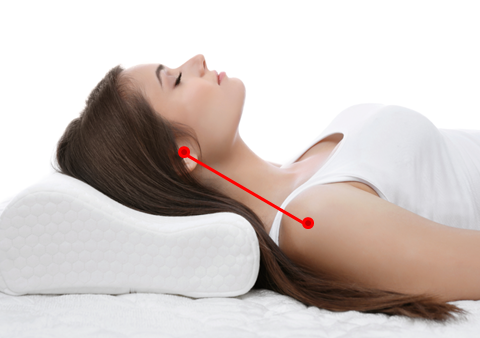
The problem is that most traditional pillows (even many so-called cervical pillows) force your body into a position that directly interferes with you getting that much needed break. Worse than that, these pillows actually train your body into a dysfunctional posture for hours on end, every single night!
2. They Compound Time Spent In Flexion
One of the defining characteristics of the modern lifestyle is an abundance of flexion-based activities. These are activities where you are seated, your head is down, your arms are out in front of you and your hands are in a grasping position.
All levels of schooling and most jobs in the modern economy require large amounts of flexion-based activity. At times, it seems that modern living has become one continuous loop of flexion-based activities. Between texting, time online, social media, video game playing & binge TV watching – It’s to the point now where nearly all of our waking hours are spent seated, with our heads down and our arms out in front of us.

Problems begin to arise with time because the load on your spine is increased significantly when your neck goes into a flexed position. In fact, research has demonstrated that the weight transferred to your spine can be as much as 6 times greater with your head at a sharp downward angle! [4] The more time you spend in flexion the more you pave the way for widespread physical dysfunction and the pain that comes with it.

When you spend hours each day in flexion-based activities, it’s imperative that give your body a break (by going into extension) while you sleep each night. Unfortunately, because of the way traditional pillows are designed they actively prevent you from going to extension.
Keeping you in this unnatural position stops your tissues from getting the break they need to ensure their proper function and longevity and in the process, it sets you up for long-term problems by contributing to your total time spent in flexion.
3. Flexion Makes It Harder To Breath
Multiple studies have demonstrated that going into a flexed (forward bending) position at the neck closes down the airway and increases resistance to airflow. Many traditional pillows force your head and neck into a position that actually makes it harder for you to breath.
A 2018 study found that even in healthy subjects (with no history of pain or neck problems), putting them into forward head position (FHP) during sleep led to “an immediate effect on respiratory function even when subjects assume FHP for a short duration of time.” [5]
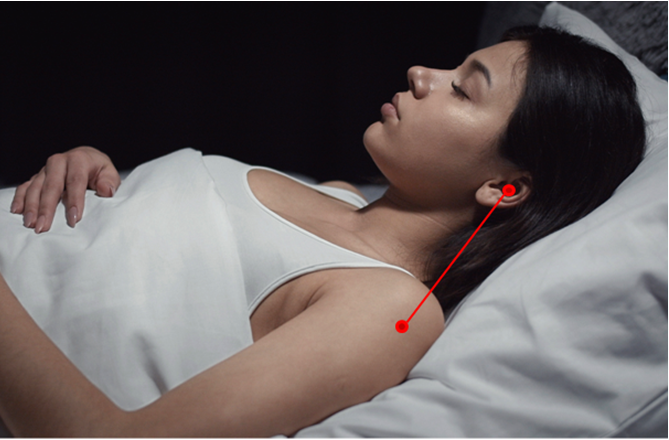
The researchers suspected that this immediate effect was the due to pressure on the nerve that supplies the diaphragm (your primary breathing muscle), which led to a weakening of its’ action. [5]
Other studies have shown that airway resistance can be immediately & significantly altered simply by varying the position of your head. Specifically, they found that flexing your neck (the position that traditional pillows encourage when sleeping on your back) leads to a significant increase in airway resistance. Meaning any time you’re in that position, it’s harder for you to get oxygen in & carbon dioxide out. [6,7]
The good news is that there’s a solution to this problem. A study on sleep apnea found that by putting people in a neutral neck position (head extension) at night improved breathing and had a host of other benefits including:
- Improved sleep efficiency
- Significantly fewer arousals
- Less awakenings throughout the night
- Subjective reports of more restful sleep [8]
4. One Size DOES NOT Fit All
People are individuals and they come in all shapes and sizes. Some people have long necks and some have shorter necks. Some people have advanced Posture Prolapse and need to get the normal curve back in their neck and some still have some of the natural curve . The needs for support vary tremendously from person to the next and the only way to to adequately address those needs is with an adjustable pillow, custom fit for that individual.
Researchers concluded that positioning the head & neck into extension with a custom-fitted cervical pillow offered “a simple, noninvasive, and comfortable means of reducing sleep-disordered breathing” in people with Obstructive Sleep Apnea. [8]
To realize the benefits though, the pillow has got to be set up just right and customized for the needs of the individual.

5. Toxic Materials That Harm Your Health & Your Sleep
Pillows and bedding are increasingly being made from man-made synthetic materials that are toxic to you and bad for the environment. [9] Very often, the main ingredient in these pillows are petrochemical-based, polyurethane foam which is derived from fossil-fuels. That’s not even the worst of it – it’s actually the cocktail of other chemicals that are added to that foam in order to transform it into Memory Foam that are the REAL DANGER. [9,10] Oh, and because many of these petro-chemicals are highly flammable, another host of chemicals has to be added to the mix make the pillow flame retardant.

Many of the chemicals used in these processes have been linked to endocrine disruption, cardio-vascular disease, cognitive delays & decreased fertility. Some of these chemicals are even known carcinogens (naphthalene & benzene ). [9,10]
Adding insult to injury, these unnatural materials cause a build up of heat around our heads which not only disrupts our sleep but, it causes the pillows to “outgas” harmful fumes that we end up breathing all night long! [10]
Our bodies need to remain cool while we sleep – even the slightest changes in temperature (as little as 0.4° C) have been shown to impact sleep in a BIG WAY. [11] Think about how many times you’ve woken up to flip your pillow over and how refreshing it feels when your face contacts the cool side of the pillow. Studies have demonstrated that cooling the head during sleep improved both subjective sleep comfort and objective sleep quality (more time spent in deep sleep). [11,12]
In contrast, the Pain Fix Pillow is made from 100% natural materials. We use no harmful chemicals, dyes or solvents at any point in the production process. Each and every thread in the final product is certified to be chemical-free. And because the pillow is all natural material, our pillows keep your head cooler and contribute to a better night of sleep.
Modern Living Is Altering Your Physical Structure
An endless parade of flexion-based activities inevitably leads to widespread physical dysfunction. That’s not the least bit surprising given that research has shown that putting the head & neck into a flexed position (like you do when texting), increases the load on your spine by as much 600%. [4]
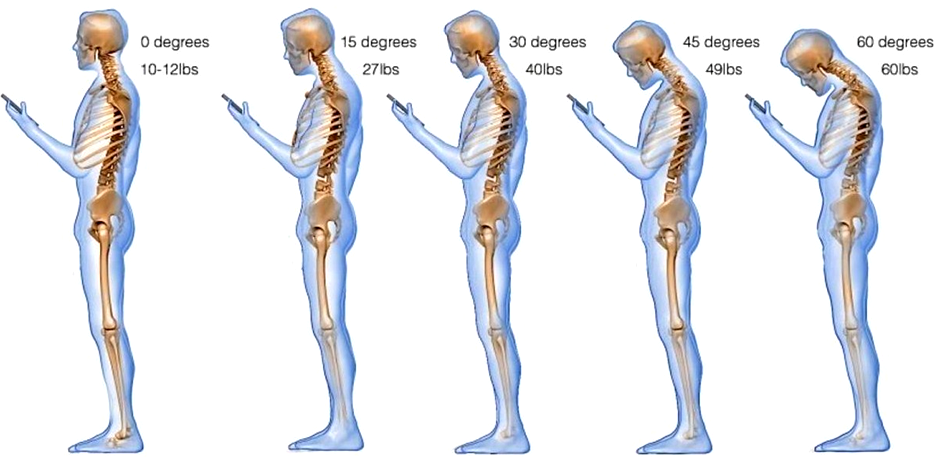
With modern living, one of the things that’s both a blessing and a curse is that everything we need to survive – things we used to be forced to engage in physical activity to get – are now readily available to us with the touch of a button.
We no longer have to get off the couch to secure our most basic needs. At any given moment, they are no more than arm’s distance away. So we don’t move, we stay plugged in and our heads stay down, buried in the task at hand.
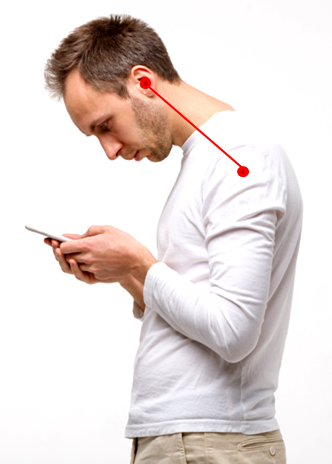
And it’s precisely this unchecked, over-abundance of flexion-based activities that’s at the root of most of the degenerative structural changes seen in the world today. Each hour you spend with your head and neck in flexion is like a rock on your back that’s weighing you down.

Over time, those rocks add up. Eventually, they wear you down, tire your body out and actually alter your structure by pulling the normal curves out of your spine. This process is no small matter – it’s chronic and it’s degenerative.
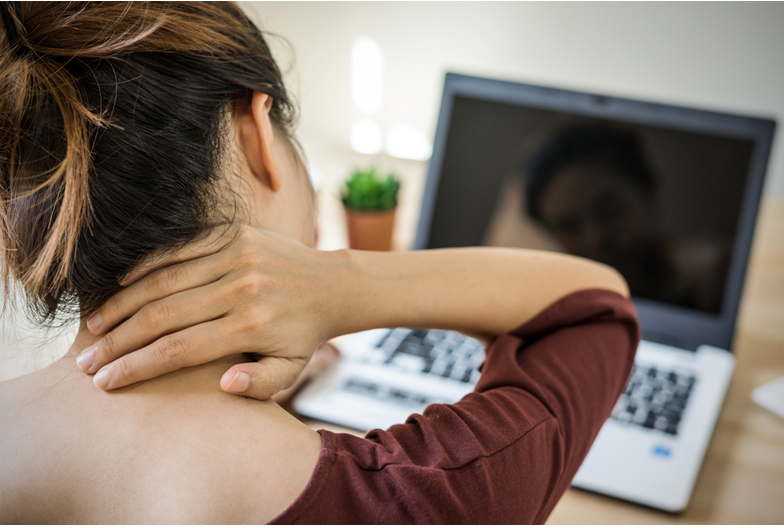
According to world-renowned medical author Dr. Rene Calliet “Head in forward posture can add up to 30 pounds of abnormal leverage on the cervical spine. This can pull the entire spine out of alignment.” [13]
Posture Prolapse is the structural embodiment of the dysfunction caused by too much time spent in flexion (without sufficient time spent in extension to counteract its affect). It can be defined as:
The progressive deterioration & collapse of all the body’s secondary curves & loss of the corresponding functionality associated with those curves.
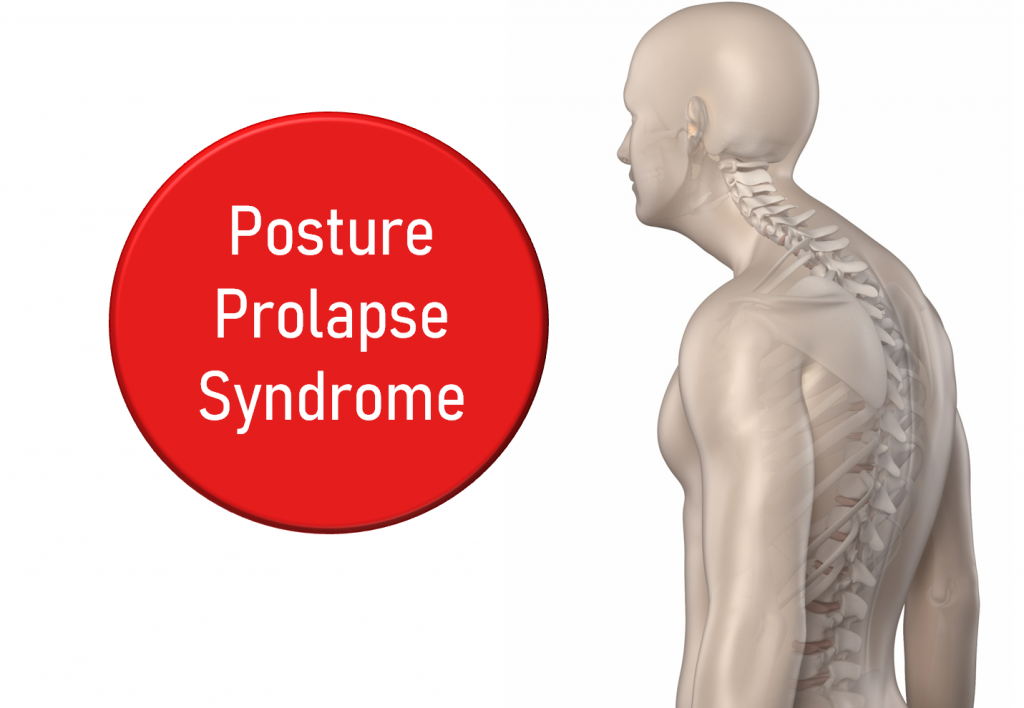
When the normal curve in the neck is lost, your head slowly sinks into what’s called a forward head position (FHP) – this is the telltale sign Posture Prolapse. Every inch of FHP increases the workload of the muscles in the neck by a factor of 10! [14]
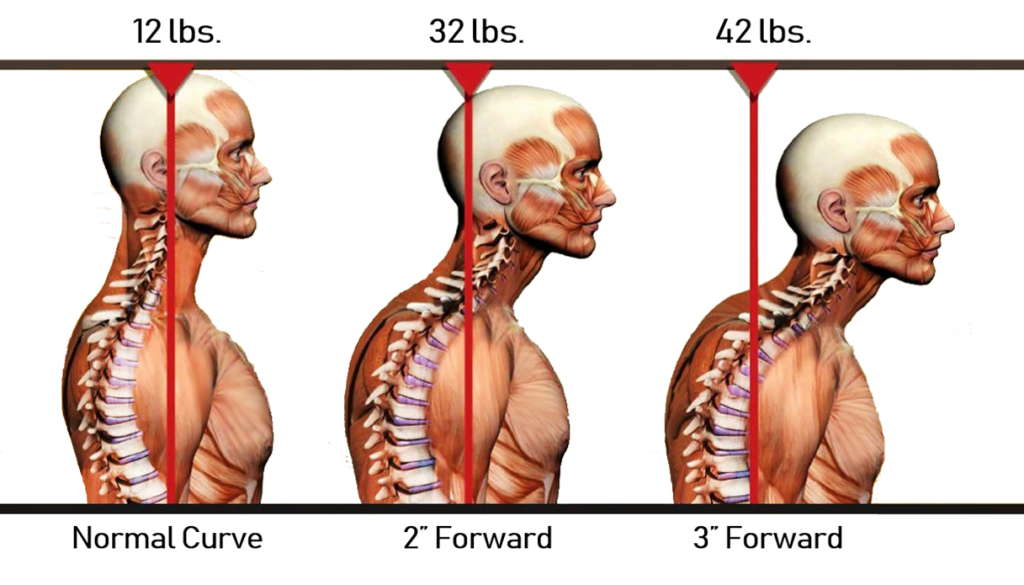
Forward Head is A Major Sign of Dysfunction
Any time you see a Forward Head Position (FHP) you know there is an tremendous burden of stress on that person’s entire body. The loss of normal head position doesn’t just affect the head and neck; it negatively impacts your whole physical structure and directly stands in the way of your body’s ability to function normally.
After a FHP is when you begin to see other structural deformations begin to show up like: – Trap Sign (Tense, over-developed, hypersensitive neck muscles) – Rounding & Internal rotation of the shoulders – Hyperkyphosis (or “Hump Back”) – Bunions – Flattening of the Feet – Clawing of the Hands
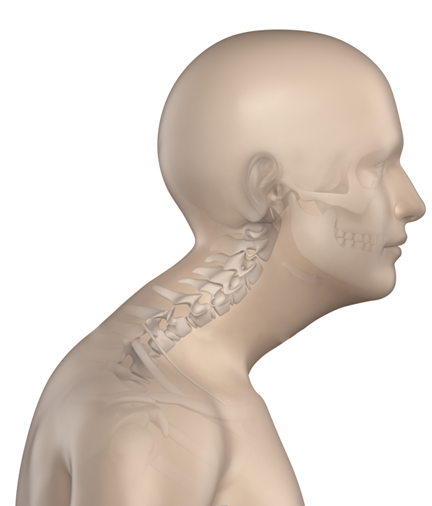
Once Posture Prolapse has been set into motion and these types of structural changes have taken place, you are likely to see functional problems like stiffness, restricted motion, difficulty breathing and fatigue begin to show up. [16,19,22]
Reduction or loss of the normal curves in the spine has been linked to the most common chronic pain conditions in the world. Here’s a short list of some of the recognized conditions with ties to Posture Prolapse [15,16,17,18,19,20,21,22,23,24] :
– Soft Tissue Pain Syndromes – Disc Herniations – Chronic Muscle Strain – Early onset Degeneration & Arthritis – Decreased Blood Flow to Spinal Cord – Increased TMJ & Bite Problems – Nerve Compression Syndromes like Carpal Tunnel & Thoracic Outlet – Impaired Breathing & Decreased Lung Capacity
If you have suffer with any of the problems listed above and you’re currently sleeping on a traditional pillow, it’s very likely that your sleep position is contributing to your problem.
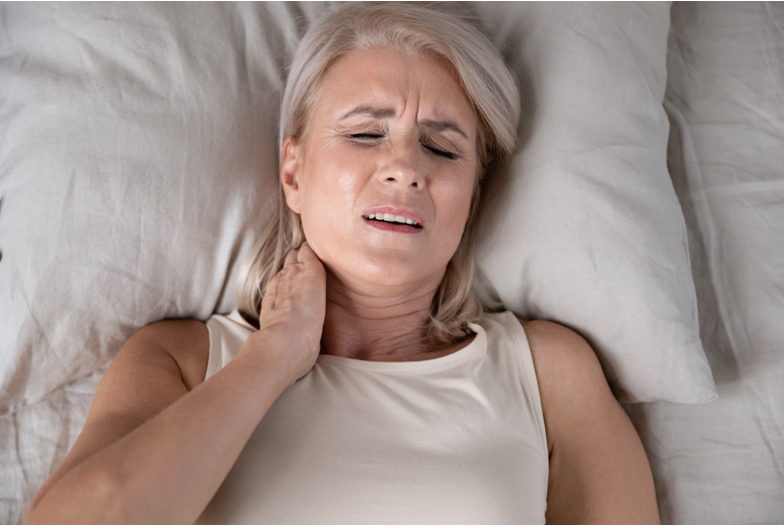
Posture Prolpase is An Epidemic
Research indicates that 70% of the population now shows overt signs of posture prolapse. [25,26,27,28] Here’s how the chief of spine surgery from one busy New York clinic explains the rash of people (including lots of young people) needing surgery nowadays:

“Just look around you, everyone has their heads down.” [29]
I want to be clear that the type of structural changes seen with Posture Prolapse – things like Forward Head Position, Tech Neck, hyperkyphosis or “hump back” & rounded shoulders are not the result of the normal aging process.

They are the result of your daily habits compounded over time.
That’s why it’s so important for people who spend hours each day in flexion-based activities, to your body a break (by going into extension) while you sleep each night.
Why Back Sleeping?
Here’s why:
- Only when you’re sleeping on your back can you be reintroducing normal curvature into your neck and your lower back.
- Research has shown that people with the worst kind Sleep Apnea have the most advanced Posture Prolapse. [5] It’s also demonstrated that the position traditional pillows make breathing more difficult. [6]

Being able to get the normal curve back in your spine is really important for anybody that has poor posture, anybody that doesn’t move as well as they’d like to & everyone suffering with chronic pain.
According to Sleep.org, back sleeping is “by far the healthiest option for most people…”. [30] Back sleeping is the only position that allows your head, neck and spine to fully decompress in a completely neutral position. Being in a perfectly neutral position feels like being weightless: your weight is fully supported, there’s zero pressure on your head, neck, shoulders and spine, and this allows your muscles to let go completely. Once you’ve achieved this state, you’re way less likely to experience pain. That relaxation is one of the reasons why so many chronic pain sufferers report relief when lying down.
We spend most of our waking hours in a position in which gravity is pulling down on our head. This is exaggerated by a modern lifestyle in which we spend an inordinate amount of time looking down – texting, typing, computer work, video games, social media, surfing the web and reading on tablets/e-readers all done with the head at a down angle. The last thing you want to be doing is sleeping in that same flexed position for 7-8 hours each night.
Research has demonstrated that custom-fitted neck pillow is an easy, inexpensive and comfortable way to fall asleep faster, breath easier, and have a deeper & more restful sleep. [8]
A 2017 study refuted the idea that sleeping on your back causes the tongue to obstruct the airway. Researchers performed endoscopies on subjects to measure the diameter of the airway while they collected data on air flow. What they found surprised even them – contrary to popular belief, gravity does not cause the tongue to fall back into the airway while back sleeping. [31]
Look & Feel Younger
In addition to restoring beautiful upright posture, the Pain Fix Pillow will gently cradle your head and neck all night long preventing damage to the delicate skin around your eyes and cheeks.
Keeping pressure off this sensitive area eliminates one of the most common causes of compressive wrinkles and Crow’s Feet on the face.
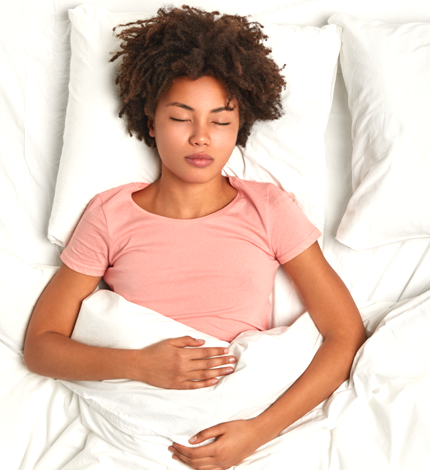
What About Position Changes?
The elephant in the room is, of course, that most people don’t spend the entire night in just one position. A 2017 study found that people change positions about 1.6 times per hour. [32] That adds up to almost 13 position changes each night! The ideal pillow needs to be able to handle and properly support a person as they go from back sleeping to side sleeping. Allowing them to maintain a neutral neck position regardless of whether they’re on their back or their side.
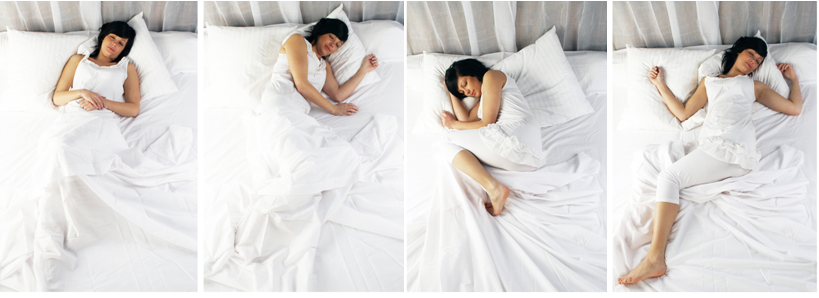
The 4 Obstacles To Proper Side Sleeping:
- Your Unique Size & Shape – Especially The Length Of Your Collar Bones. What we’re looking at here is the distance from the downside of their head and neck to the tip of their shoulder. This space needs to be accounted for with the pillow when side sleeping, that’s the whole point of the pillow. It also varies widely from person to person. Now, a person with narrow shoulders can use a much thinner pillow, whereas a person with broad shoulders will need a much thicker pillow to fill that larger gap.
- Your Sleep Surface – What Kind Of Mattress Are You Sleeping On?
If your mattress is soft, old, or unsupportive, your body is going to be allowed to sink down into that and that’s going to narrow this gap, which means you’re going to need a thinner pillow. If you have a firm or hard mattress, that’s going to push you upward, meaning it’s going to increase the size of the gap and you’re going to need a thicker pillow to fill that space.

-
The Thickness, Density & Overall Construction Of Your Pillow. This factor receives a ton of attention, mostly from companies that are trying to sell you the “perfect pillow.” There are two factors that we’ve already talked about that are influencing the size of that gap significantly. How could you ever have one perfect pillow solution for a person that has say, broad shoulders and they’re lying on a firm mattress, and then a person with narrow shoulders who’s lying on a soft mattress? It’s just not possible for a single pillow to account for so many variables. The only logical solution to fill this gap properly is to have a pillow that has an adjustability feature to accommodate different sizes.
- What Are Your Doing With Your Downside Arm?
If you’re shoving a hand in there, you’re altering the size of the gap that you’re trying to fill. If you’re shoving your whole arm in there, well then you’re radically altering the size of the gap that you’re going to fill. All of that plays into the adjustability feature of the pillow that you’re going to want to use to achieve that ideal height for sleeping on your side.
What People Are Saying About The Pain Fix Pillow™
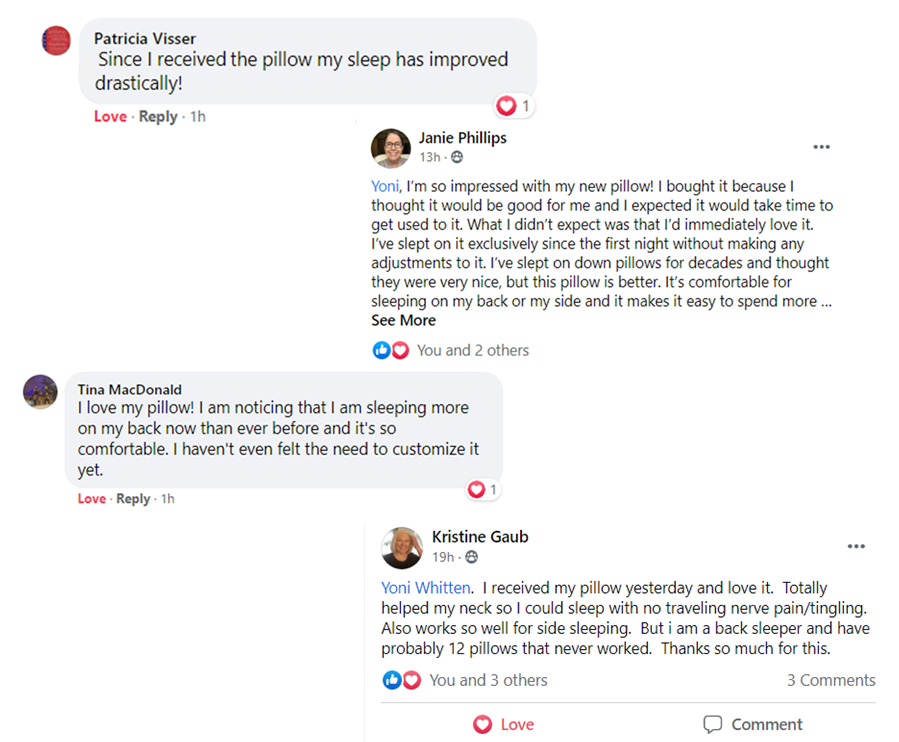

Improve Your Posture & Eliminate Pain While You Sleep With The Pain Fix Pillow™
Key Features:
- Specially designed to re-introduce & preserve the normal neck curve.
- Massive pressure relief for your neck, shoulders & spine.
- Four Distinct Sleep Zones – Ideal for back & side sleepers
- 100% Adjustable – Dual-Sided Invisible Zippers.
- Simply add or remove fill to get your ideal support level.
- Shape it, Bend it & Position it to fit your individual needs to perfection.
- Custom blend of Natural Fibers to get a “soft & springy” feeling:
- 100% Natural Latex Noodles
- 100% Natural Shropshire Wool “Wisps”
- Covered in 100% natural cotton sateen quilted case – for a luxurious feel and the ultimate in sleep comfort.
- Put an end to overheating, sleep disturbance & night sweats that come with down, feathers, foam & synthetic fills.
- Experience the countless benefits of wool and latex.
- Naturally hypoallergenic.
- Dust mite resistant
- Anti-microbial
- Our products are 3rd party tested and certified to be free of arsenic, VOC’s & other carcinogenic chemicals that are used in majority of the conventional bedding such as down, polyester & silk.
- By purchasing the Pain Fix Pillow, you support many local economies around the world, protect the environment from pollution, promote balanced eco system & prolong your health.
- Machine washable.
- Size: queen size only
- 5 year manufacturer warranty
Good For You : Good For The Planet
We’re proud to announce that The Pain Fix Pillow is OEKO-TEX® Certified! When you see the OEKO-TEX® label, it means that you can be certain that each and every thread of that product has been tested for harmful substances and that the product has been found to be completely harmless to human health.

OEKO-TEX® testing is carried out by independent laboratories, in accordance with extensive criteria laid out by OEKO-TEX®. It accounts for numerous regulated and non-regulated substances, which may be harmful to human health. In many cases, the limit values set by OEKO-TEX® go far beyond national and international requirements.
OEKO-TEX® criteria is updated at least once a year and expanded with new scientific knowledge & statutory requirements. It is not easy for manufacturers and customers to keep an overview of the legal situation concerning harmful substances every day. Thankfully the experts at OEKO-TEX® institutes do this for us.
References:
-
- Boos N, Wallin Å, Gbedegbegnon T, Aebi M, Boesch C. Quantitative MR imaging of lumbar intervertebral disks and vertebral bodies:influence of diurnal water content variations.Radiology. 1993;188:351–354.
- Matsumura Y, Kasai Y, Obata H, Matsushima S, Inaba T, Uchida A. Changes in water content of intervertebral discs and paravertebral muscles before and after bed rest. J Orthop Sci. 2009;14(1):45–50. doi:10.1007/s00776-008-1288-5.
- Roberts N, Hogg D, Whitehouse GH, Dangerfield P. Quantitative analysis of diurnal variation in volume and water content of lumbar intervertebral discs. Clin Anat. 1998;11:1–8.
- J Naresh-Babu, Viswanadha Arun-Kumar, and D G S Raju. Surgeon’s Neck Posture during Spine Surgeries: “The Unrecognised Potential Occupational Hazard”. Indian J Orthop. 2019 Nov-Dec; 53(6): 758–762.
- Hamayun Zafar, Ali Albarrati, Ahmad H. Alghadir, Zaheen A. Iqbal, “Effect of Different Head-Neck Postures on the Respiratory Function in Healthy Males”, BioMed Research International, vol. 2018, Article ID 4518269, 4 pages, 2018.
- Chaiane Facco Piccin, Daniela Pozzebon, Fabricio Scapini, and Eliane Castilhos Rodrigues Corrêa Craniocervical Posture in Patients with Obstructive Sleep Apnea. Int Arch Otorhinolaryngol. 2016 Jul; 20(3): 189–195.
- Jae-Kap Choi, Michael Goldman, Sankar Koyal, Glenn Clark. Effect of Jaw and Head Position on Airway Resistance in Obstructive Sleep Apnea. Sleep Breath. 2000;4(4):163-168.
- C A Kushida, C M Sherrill, S C Hong, L Palombini, P Hyde, W C Dement. Cervical positioning for reduction of sleep-disordered breathing in mild-to-moderate OSAS. Sleep Breath. 2001 Jun;5(2):71-8.
- Walter Bader. Toxic Bedrooms: Your Guide to a Safe Night’s Sleep. April 1, 2011
- Brandon E Boor, Helena Järnström, Atila Novoselac, Ying Xu. Infant exposure to emissions of volatile organic compounds from crib mattresses. Environ Sci Technol. 2014 Mar 18;48(6):3541-9.
- Edward C. Harding, Nicholas P. Franks, and William Wisden. The Temperature Dependence of Sleep. Front Neurosci. 2019; 13: 336.
- Kazue Okamoto-Mizuno and Koh Mizuno. Effects of thermal environment on sleep and circadian rhythm. J Physiol Anthropol. 2012; 31(1): 14.
- Cailliet R, Gross L, Rejuvenation Strategy. New York, Doubleday and Co. 1987
- Troyanovich et al. Structural rehabilitation of the spine and posture: Rationale for treatment beyond resolution of symptoms. JMPT 1998; 21 (1).
- Trigger Points in the SuboccipitalMuscles and Forward Head Posture in Tension-Type Headache. Headache: J. Head & Face Pain 2006 Mar; 46 (3): 454—460
- McAviney J, Schulz D, Bock R, Harrison DE, Holland B. Determining the relationship between cervical lordosis and neck complaints. J Manipulative Physiol Ther. 2005 Mar-Apr;28(3):187-93.
- Harrison DD, Harrison DE, Janik TJ, Cailliet R, Haas JW, Ferrantelli J, Holland B. Modeling of the Sagittal Cervical Spine as a Method to Discriminate Hypo-Lordosis: Results of Elliptical and Circular Modeling in 72 Asymptomatic Subjects, 52 Acute Neck Pain Subjects, and 70 Chronic Neck Pain Subjects. Spine 2004; 29:2485-2492.
- NagasawaA1, SakakibaraT, Takahashi A. . Roentgenographic findings of the cervical spine in tension-type headache. Headache.1993 Feb;33(2):90-5
- Increased Forward Head Posture and Restricted Cervical Range of Motion in Patients with Carpal Tunnel Syndrome. Journal of Orthopaedic & Sports Physical Therapy 2009 (Sep); 39 (9): 658—664
- J Shoulder Elbow Surg.2015 Mar;24(3):446-52. The impact of faulty posture on rotator cuff tears with and without symptoms.YamamotoA, et. al.
- Lee, WY, et al. J. of OrofacialPain – The relationship between FHP & tempromandibularDisorders 1995
- Lennon et al. Postural and Respiratory Modulation of Autonomic Function Pain & Health. Amer J Preventative Med Vol 4. No. 1 January 1994.
- Freeman JT., Posture In The Aging and Aged Body,JAMA 1957; 165 (7), pp 843-846
- Mayo Clinic Health Letter, Vol. 18, No. 3, Mar 2000.
- Ramalingam & S. Ambusam. Prevalence and Associated Risk Factors of Forward Head Posture among University Students. Indian Journal of Public Health Research and Development10(7):775 · January 2019
- D. Anap & J.A. Mamania. Prevalence of Forward Head Posture amongst Physiotherapy Students: A Cross- sectional Study. International Journal of Education and Research in Health Sciences, October- December 2018;1(4):125-127
- Bashir, Naz & Noor. Prevalance of forward head posture among university students. Rawal Medical Journal43(2):260-262 · April 2018
- Verma et. al. Prevalence of forward head posture among 12-16 year old school going students – A cross sectional study. Applied Medical Research, 2018. Vol 4 (2)
- Lindsey Bever. ‘Text neck’ is becoming an ‘epidemic’ and could wreck your spine. The Washington Post. November 20, 2014
- https://www.sleep.org/best-sleep-position/
- Melania Marques, Pedro R Genta, Scott A Sands, Ali Azarbazin, Camila de Melo, Luigi Taranto-Montemurro, David P White, Andrew Wellman.Effect of Sleeping Position on Upper Airway Patency in Obstructive Sleep Apnea Is Determined by the Pharyngeal Structure Causing Collapse. 2017 Mar 1;40(3):zsx005.
- Eivind Schjelderup Skarpsno, Paul Jarle Mork, Tom Ivar Lund Nilsen, and Andreas Holtermann. Sleep positions and nocturnal body movements based on free-living accelerometer recordings: association with demographics, lifestyle, and insomnia symptoms. Nat Sci Sleep. 2017; 9: 267–275.
